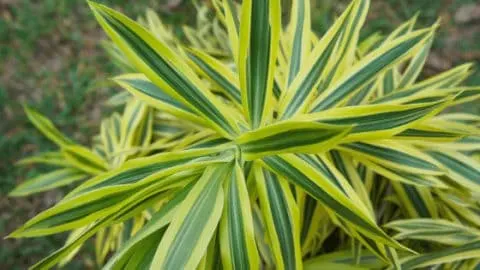You are reading this article to learn more about the Dracaena reflexa care and the Song of India houseplant.
What is the Song of India?
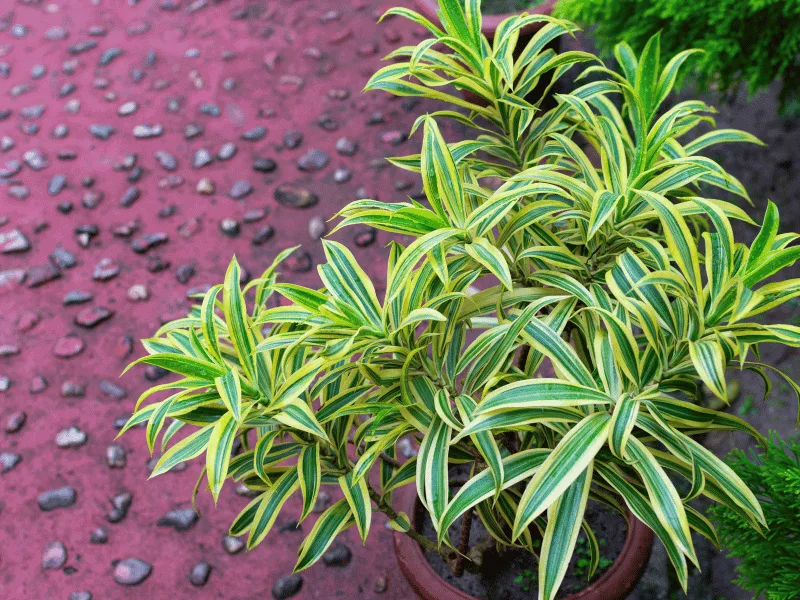
The Dracaena reflexa plant or Dragon tree is endemic to Madagascar, Mauritius, and other islands of the Indian Ocean. It is yet another species of the large Dracaena genus. It is an evergreen shrub with dark green leaves that grow in whorls.
It was first introduced in 1786 by Jean-Baptist Lamarck and has become a common ornamental plant.
It is a popular Dracaena species known as the Song of India or Pleomele.
The genus name is drawn from the Greek word ‘drakaina,’ which means a female dragon. NASA used it in its Clean Air Study plans to demonstrate its ability to eliminate formaldehyde.
The leaves are the biggest appeal of this visually impressive houseplant. The yellow lines depicted on the narrow pointed leaves cannot be overlooked. This adaptable indoor houseplant thrives on a patio or a partially shady outdoor field.
This houseplant goes by many names in the market; the common ones are Dracaena Reflexa Song of India and Song of Jamaica. It has about 13 accepted varieties that produce thick leaves and irregular stems.
Dracaena reflexa Takeaways
| Species | Dracaena reflexa |
| Synonyms | Dragon tree, Pleomele reflexa, Cordyline reflexa, Dracaena reflexa var. typica, Draco reflexa, Lomatophyllum reflexum |
| Family | Asparagaceae |
| Genus | Dracaena |
| Growth | Upright growing shrub. |
| Height | 18 feet |
| Width | 8 feet |
| Soil | Well-draining loamy soil |
| Watering | Every 5-7 days |
| Light | Bright indirect |
| Temperature | 65-78°F (18-25.5°C) |
| Humidity | 40-50% |
| Fertilizer | Fertilize every two weeks in spring and summer |
| Propagation | Stem cuttings |
| Toxicity | Toxic to humans and animals such as cats and dogs. Contains saponins. |
Table of Contents
Dracaena reflexa Plant Care
To care for Dracaena reflexa indoors, provide bright indirect light. Use loamy, well-draining soil. Water sparingly about once a week. It grows best at temperatures ranging from 65-78°F (18-25.5°C). 40-50% humidity is fine. Fertilize your plant once a month in spring and summer when it is actively growing.

Song of India Care Regimen
The Best Soil for your Indoor Plant
Dracaena reflexa thrives in a well-drained, loamy potting mix with plenty of organic materials. Mixing in some compost or peat moss before planting your Dracaena Reflexa is a good suggestion. Your container should also have proper drainage at the bottom, so water does not get trapped in its soil.
The ideal potting soil is a blend of one part peat moss, one-part houseplant soil, and one part perlite. This soil mix offers essential nutrients and allows fast and easy drainage.
Water
Water about once every seven days.
Dracaena Reflexa requires less water than most indoor plants do. Keep your Dracaena Reflexa hydrated by misting the leaves with water and moistening the soil. Always let the topsoil dry out before watering.
Do not overwater, as it may trigger root rot. This plant prefers the soil on the dry side.
Sagging or yellowing leaves can suggest overwatering or poor drainage, but do not stress that your bottom leaves start yellowing and dropping. Dracaena can usually dump old/mature leaves to produce new ones.
These plants are susceptible to fluoride. It is usually present in tap water; it is, therefore, important to use filtered water.
The fluoride toxicity is visible in leaves with dark brown, dead areas, and yellow edges. Dracaena Reflexa should be watered extra in the development stage and less during the fall or winter when inactive.
Dracaena reflexa Light
The ideal light level for Dracaena reflexa is bright, indirect light.
Dracaena Reflexa is perfectly suited for indoor lighting. It can withstand extreme, medium, and low light levels.
Direct sun will result in scorched blade ends, while too little light could result in faded or curled leaves. Preferably it can do best in moderate light, so it is advantageous to put it in artificial light sources during the day for substantial periods.
High light works, but water needs also increase. In high light, the danger of pest infection may also increase. While Dracaena Reflexa is a low-light hardy, it achieves the best growth with a few hours of bright sunlight.
Temperature
Dracaena Reflexa prefers temperatures ranging from 65 to 78 degrees Fahrenheit (18 to 25.5 degrees Celsius) throughout the day.
Cooler nights are good for flower growth. Very cold temperatures below 55 degrees Fahrenheit (12.7 degrees Celsius) can damage the plant.
Ensure that your Dracaena Reflexa is kept from the heating or cooling units.
Humidity
Dracaena Reflexa loves humidity. It is indigenous to subtropical climatic conditions.
This houseplant adapts to standard room humidity. 40-50% is sufficient. It is the healthiest outdoors in warm, humid regions.
The leaf tips can become brown and ultimately decline if there is too low humidity.
You can elevate the humidity in your house by putting a humidifier close to the plant.
You can also position your Dracaena Reflexa plant on a narrow platter of pebbles with water covering the pebbles.
As the water evaporates, it will offer extra moisture for your Dracaena Reflexa.
Misting the leaves of your Dracaena Reflexa every few days is not a great idea. It will only increase the risk of bacteria and wilt on the green leaves.
Fertilizer
Dracaena Reflexa does not need much fertilizer, particularly if planted in peaty soil with much organic substance.
The safest way to feed your Dracaena Reflexa is to use a thin layer of compost around your plant in the early spring. Roughly a quarter to a half-inch of manure will generally fulfill the needs.
I like using houseplant fertilizer; feed your Reflexa once every two weeks in summer and spring. Reduce the fertilizer use in the fall, and stop feeding your Reflexa plant entirely in the winter.
Applying too much compost or fertilizer can burn the Dracaena’s roots.
Repotting
You will only need to repot your Dracaena Reflexa plant every few years because it is an exceptionally slow grower.
When you repot, make sure to use fresh potting soil, give your Dracaena Reflexa a lot of new areas to develop into, and let it have a little additional sunlight for a few days.
Avoid the urge to overwater your Dracaena Reflexa when repotting. Wait for five to seven days before watering it in the new pot and soil, or it may face drooping or yellowing leaves.
You can divide and repot it in a moist sand pot or a glass of water. Place the cane in a large container filled with potting soil when the roots are established.
Pruning
Dracaena Reflexa can grow very big but are simple to cut off when necessary. Use a sharp, clean knife or cutters to prune your plant for better results when it is actively grown in spring or summer.
It’s a good idea to dip the knife blade into the water and little bleach earlier so that no plant diseases are transferred.
As you prune, cut the stems called canes at a single point. Start by removing any wounded canes and dead or infected leaves.
Use clean, sharp pruners to prune because weak cuts can increase the chances of diseases. Wear gloves and protective goggles to keep yourself safe as these are toxic plants.
Dragon Tree Flowering
The Dragon Tree produces white flowers that are very strongly scented. Mature flowers can turn dark in shades of red and yellow.
Orange-red berries occasionally follow flowers. Flower blossoming is often reflexed (bent downward), therefore the name Reflexa.
Dracaena reflexa Growth Rate
Dracaena reflexa plants reach a height of 156 – 192 inches (13 to 16 feet) tall. The plant rarely grows to 228 inches (19 feet) tall.
The biggest feature of this species is its leaves. These leaves are shiny over the arch and expand up to 12 inches (1 foot) long and a few inches wide.
They slowly lose the base leaves as the plant gets bigger. Nevertheless, the plant is far shorter when cultivated as an indoor houseplant.
The plant can be grown in nearly any pattern, the most common being bush, straight cane, staggered cane, tree form, or custom character forms.
Dracaena Reflexa can grow well outdoors in warmer areas within the USDA plant hardiness zones 10 to 12.
Dracaena reflexa Propagation
You can effortlessly propagate Dracaena deflexa from cuttings.
- You can take cuttings from the highest point of the plant or the stem.
- If you’re using top cuttings, cut the Dracaena Reflexa with pruning shears along the leaf line of the plant. Choose a piece that contains multiple stem nodes.
- If you are taking stem cuttings, cut a huge slice of the stem, and take sections about 8 inches long with a few leaf nodes.
- Scrub the bottom side of the cuttings with rooting hormone. This step is not obligatory but significantly improves your opportunities for effective propagation.
- Those chances are already quite high because Dracaena Reflexa plants are very effortless to propagate; the rooting hormone does make the procedure quicker and more consistent.
- Position the bottom of your cuttings in moist soil or fresh water.
- Now, place your container in a warm place with a lot of indirect sunlight.
- Once the cuttings grow roots, you can transfer them to a larger, potting mix-filled container.
- In a few days, you will have your young Dracaena Reflexa plant.
Pest Problems for a Dracaena Plant
Dracaena Reflexa is somewhat pest-free. Fungus gnats can be a concern when planted in compost or bark soil, so use potting or planting without these elements to prevent this.
Scale, aphids, thrips, and mealybugs are pests that occasionally extract sap from Dracaena Reflexa leaves, declining the plant and even killing it. Check below your plant’s leaves, along its trunk, and at its base for these types of insects. More details are given in the section below.
Mealybugs
Mealybugs look similar to white, fuzzy, or cottony masses. Attempt blasting mealybugs off with a strong spray of water from the sprayer at your kitchen sink.
If your Dracaena Reflexa plant is outside, wash it with a garden hose. You can also use a cotton ball or swab sunk in rubbing alcohol to wipe the bugs. Wash your plant with clean water when you are finished.
Aphids
Aphids can be green or black, with round, translucent features. They trigger leaves to be yellow and frequently leave a sticky discharge on your Dracaena.
Wash them off with a fabric dipped in soapy water or apply insecticidal soap.
Scale Insects
The scale is tiny tan, dark brown, or white pests with waxy covers. Ecological predators like ladybugs and parasitic wasps can assist in regulating them on outdoor plants.
Use an old toothbrush dipped in soapy water for indoor plants to scrub them off. If the scale continues reappearing, apply an insecticidal spray or horticultural oil following the product’s instructions.
Spider mites
Spider mites are too tiny to be seen without a magnifying glass, but you can suspect they are present if you observe many small brown or yellow points on your Dracaena Reflexa leaves.
They mostly appear during a warm climate. You may find out their eggs beneath the foliage. Try spraying spider mites off with water. If that doesn’t regulate them, apply a miticide, following the brand guidelines.
Thrips
These little, winged insects can also harm Dracaena Reflexa. They can be washed away with water, and severely infected leaves must be cut off. Prevent supplying your plant with a fertilizer high in nitrogen, frequently resulting in raw, new growth that invites these pests.
Fungal Diseases
Dracaena Reflexa is often unaffected by fungus but may suffer from soft rot and leaf spots in the fusarium.
Watering Dracaena reflexa at the foundation helps in preventing fungal problems. You should not water on their leaflets. Leaf spots can be handled with fungicides, but if your plant has a severe infection, go ahead and discard it because soft rot cannot heal on Dracaena plants.
General Problems
Yellow Leaves
When older leaves turn yellow, it is usually normal. Especially if it is the lower leaves. If newer top leaves turn yellow, the cause is often overwatering. It can also be underwatering or a pest infestation.
Identify the cause and act accordingly. If the soil is still moist, take the plant out of the pot. Wash the roots. Use new potting soil. Disinfect the pot. Put the plant back in.
Brown Leaf Tips
These indoor plants are sensitive to fluoride. It is best to let tap water sit for 24 hours before watering the plant. This can help to prevent brown leaf tips.
Spindly Growth
Leggy growth is caused by insufficient light. Your reflexa may grow spindly if you provide less than filtered light. It can survive in low light but will not thrive.
Dracaena Reflexa Care Tips in a Nutshell
- Use filtered water, as Dracaena Reflexa is sensitive to salts and chemicals in most tap water.
- While the Dracaena Reflexa is keenly developing in the spring and summer, feed it with a diluted simple houseplant food.
- Normal humidity is sufficient. Dracaena Reflexa is an extremely hardy houseplant, but its native rainforest atmosphere favors higher moisture.
- The best spot for your Dracaena Reflexa is placing it in partial and not direct sunlight; however, a few hours in the direct sun are great.
- Feed your Dracaena Reflexa with a fertilizer that contains enough nutrients to make your plant happy and healthy.
- Clean your pruning shears to keep your plant disease-free. You can use bleach or alcohol for this.
Other Dracaena Species
1. Dracaena fragrans (Corn Plant)
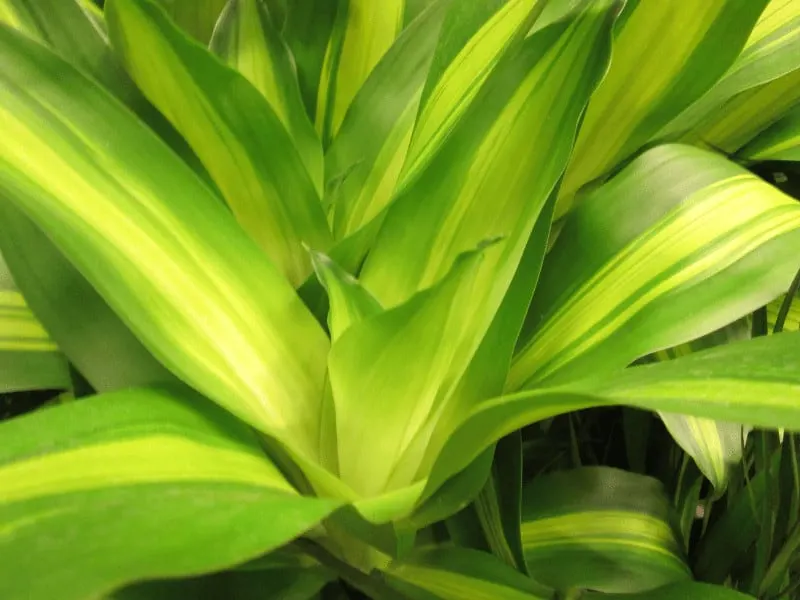
Dracaena fragrans (Dracaena deremensis) known as the Corn Plant, are sold as one or multiple stems. The leaves are green with a yellow band in the center.
2. Dracaena marginata (Dragon Tree)
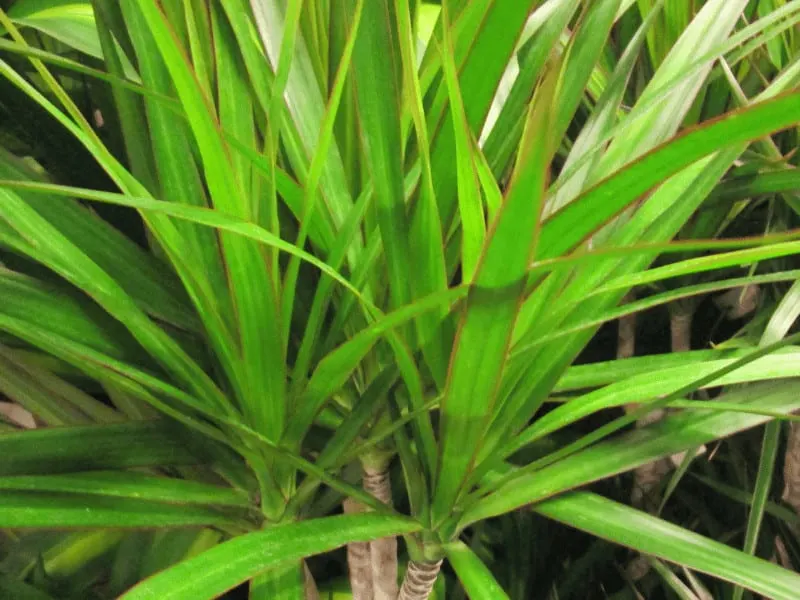
Dracaena marginata is known as the Dragon Tree. It has one or multiple slender stems and long spindly green leaves with red edges.
3. Dracaena sanderiana (Lucky Bamboo)
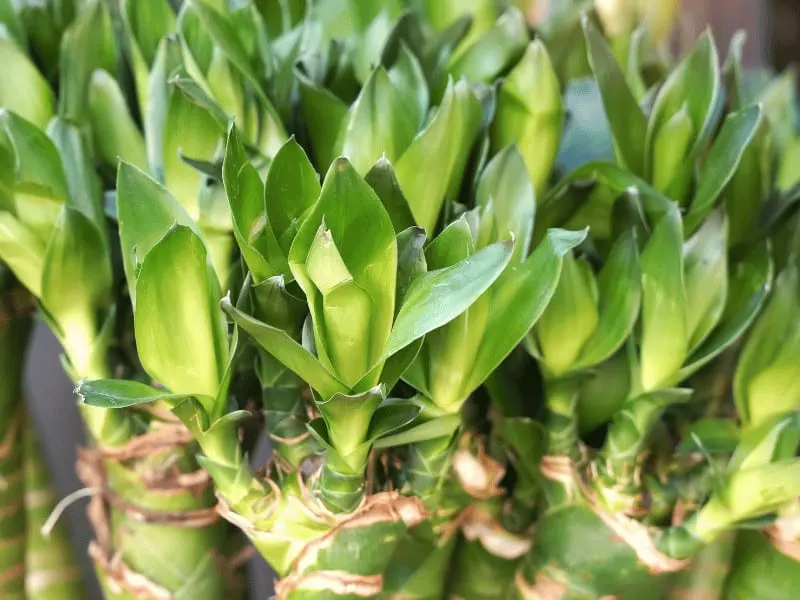
Dracaena sanderiana is commonly known as the Lucky Bamboo. But the Lucky Bamboo isn’t a bamboo plant but a Dracaena species.
4. Dracaena fragrans ‘Massangeana’ (Mass Cane)
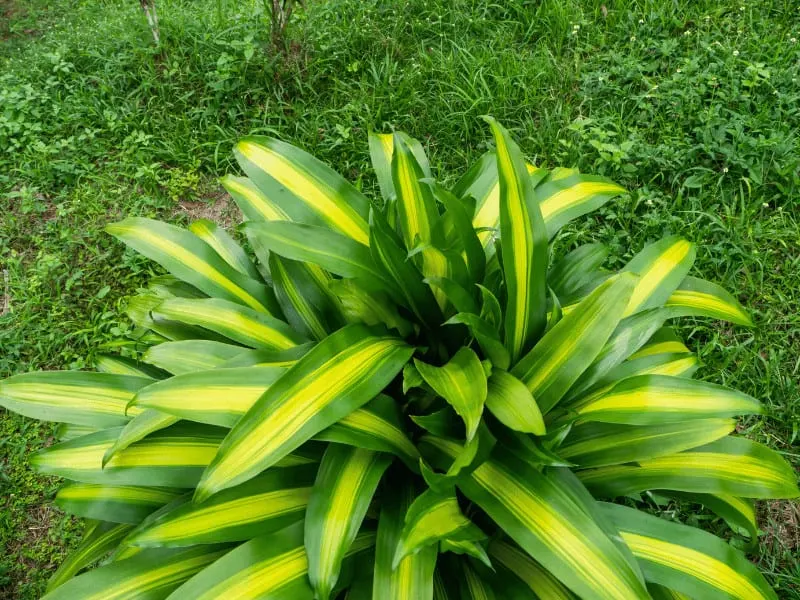
Dracaena fragrans ‘Massangeana’ is known as the Mass Cane plant. It has long green and golden leaves.
5. Dracaena compacta (Dwarf Dracaena)
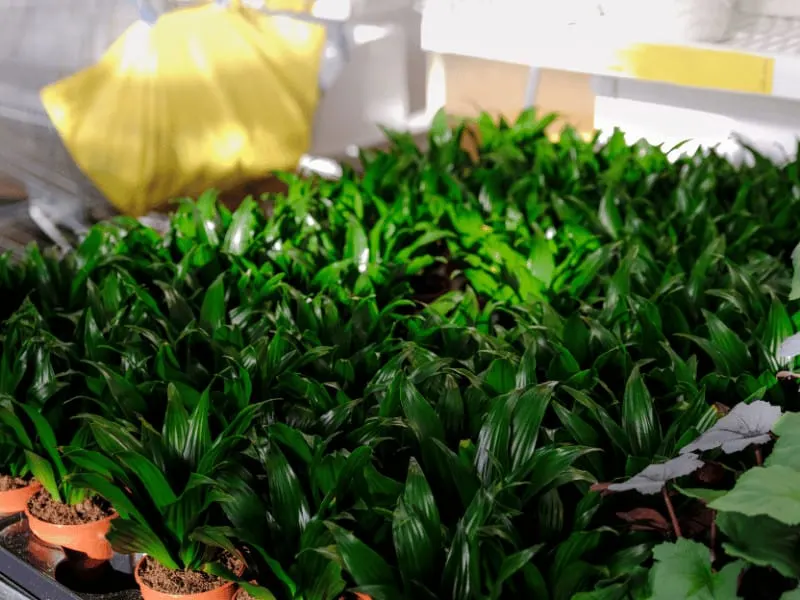
Dracaena compacta (Dwarf Dracaena) is the bonsai variety of Dracaena species. It can, however, reach a height of 6 feet (183 cm) and grow up to 4 inches per year (10 cm).
Dracaena Reflexa Varieties
There are multiple reflexa varieties, such as:
- Dracaena reflexa var. subcapitata
- Dracaena reflexa var. salicifolia
- Dracaena reflexa var. reflexa
- Dracaena reflexa var. nitens
- Dracaena reflexa var. linearifolia
- Dracaena reflexa var. lanceolata
- Dracaena reflexa var. cernua
- Dracaena reflexa var. brevifolia
- Dracaena reflexa var. bakeri
- Dracaena reflexa var. angustifolia
Is Dracaena Toxicity to Cats?
Dracaena is toxic to cats and dogs as well as humans. It causes vomiting, salivation, diarrhea, and depression, according to ASCPA.
Frequently Asked Questions
Is Dracaena reflexa toxic?
Dracaenas are poisonous to dogs and cats. Don’t let your animals consume your plant. Poisoning side effects include nausea, losing weight, loss of appetite, and hypersalivation. If your pet has eaten or chewed Dracaena Reflexa, seek medical assistance.
Where should I plant my Dracaena reflexa?
When selecting the appropriate location to plant your Dracaena Reflexa, think about sunlight and humidity. See for a region in your lawn or home that gets just the right amount of light and where the air is not too dry.
How frequently should I water my Dracaena reflexa?
Dracaena reflexa does not need a lot of water and is happiest when its soil is kept somewhat moist but never soggy. Water about once a week or every other week, letting the soil dry between watering.
How fast do Dracaena reflexa grow?
The plants grow at a relatively slow pace that varies upon their developing environments. It grows moderately when planted in an idyllic atmosphere and cared for well. These tropical plants grow most in spring and summer and rest in winter.
Conclusion
Dracaena Reflexa is primarily used as an indoor houseplant and outdoors for landscaping.
The leaves and stems of the variety are also mingled with other indigenous plants to make herbal teas.
Like other Dracaenas, these are relatively effortless to care for and grow as they can survive some neglect.
Reflexa is an ornamental house plant that can flourish in subtropical environments where temperatures are high.
To care for Dracaena Reflexa, provide a temperature between 65 to 78 degrees Fahrenheit (18 to 25.5 degrees Celsius), water once a week, and use well-draining loamy soil. Provide bright indirect light and humidity of 40-50%.

Daniel has been a plant enthusiast for over 20 years. He owns hundreds of houseplants and prepares for the chili growing seasons yearly with great anticipation. His favorite plants are plant species in the Araceae family, such as Monstera, Philodendron, and Anthurium. He also loves gardening and is growing hot peppers, tomatoes, and many more vegetables.

